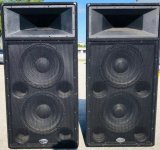TE-8180 1" Horn 22.5" x 10" 1-3/8"-18 TPI
We don't like diffraction slots for the most part- but look at the angles in this instance- very mild changes in the throat, and overall, relatively smooth from what I can tell in the pictures. For those of us with screw-on drivers that can play low like JBL 2426, these may be a good option for 500-5khz, particularly with a little effort on damping around the mouth, since the step there is a little more pronounced and there's no proper termination.
We don't like diffraction slots for the most part- but look at the angles in this instance- very mild changes in the throat, and overall, relatively smooth from what I can tell in the pictures. For those of us with screw-on drivers that can play low like JBL 2426, these may be a good option for 500-5khz, particularly with a little effort on damping around the mouth, since the step there is a little more pronounced and there's no proper termination.
They were used in the B-52's LX1515...
Yes- certainly not the finest pedigree. I'm rather skeptical of the 500Hz claim, though it's a relatively deep horn. Looks like my winter speaker testing will be oriented around screw on drivers- I ordered these, a pair of 2374s (screw on 1" version of the 2384), a pair of 2408h-2.
The drivers available will be the robust JBL 2426h, my modified (coated diaphragms) Selenium D2500Ti, and the JBL 2408h-2, basically a spectrum from very capable at LF (2426) but limited top end, to exceptional top end (ring radiator 2408h-2) but limited LF.
Crossover will be active, so I can push somewhat lower than might otherwise be possible as I'll roll them off very steeply.
So, the good first- the throats are as smooth as they look. It's a very mild profile expansion at the first flare, done gently. There's a substantial amount of depth to them, which should help them operate lower.
The bad- the ridge closer to the mouth is pretty sharp.
The Ugly. Build quality. Some rough seams where sections were joined are the least of it. Cheap threads, a throat input that for some reason is angled (tapers into the throat instead of a step for the driver to couple to), plastic molten on the threads that made getting the driver properly screwed on a pain.
So there's definitely room for improvement, by lining the horn starting a bit before the mouth flare with some absorption, that ridge should be able to be mitigated. More material around and on the mouth itself would soften any edge diffraction. The throat can use some love, primarily with just smoothing the driver-horn interface (it's angled, so a little fillet of modeling clay would smooth it out).
They're not awful in terms of materials used, the threads may be bronze and the plastic is of okay enough quality. The throat is the hardest part and these seem to get that right (given using a little tweaking right at the driver coupling). I'm interested to see how they shake out when I get a mic on them.
The bad- the ridge closer to the mouth is pretty sharp.
The Ugly. Build quality. Some rough seams where sections were joined are the least of it. Cheap threads, a throat input that for some reason is angled (tapers into the throat instead of a step for the driver to couple to), plastic molten on the threads that made getting the driver properly screwed on a pain.
So there's definitely room for improvement, by lining the horn starting a bit before the mouth flare with some absorption, that ridge should be able to be mitigated. More material around and on the mouth itself would soften any edge diffraction. The throat can use some love, primarily with just smoothing the driver-horn interface (it's angled, so a little fillet of modeling clay would smooth it out).
They're not awful in terms of materials used, the threads may be bronze and the plastic is of okay enough quality. The throat is the hardest part and these seem to get that right (given using a little tweaking right at the driver coupling). I'm interested to see how they shake out when I get a mic on them.
Last edited:
- Status
- This old topic is closed. If you want to reopen this topic, contact a moderator using the "Report Post" button.
